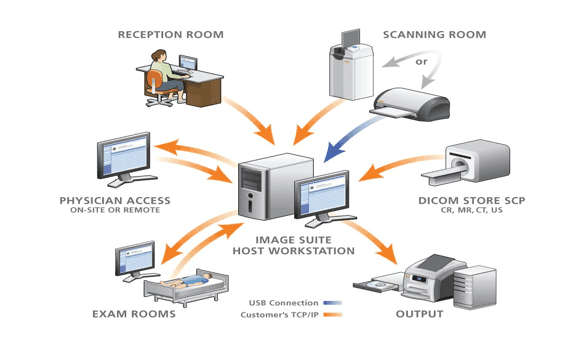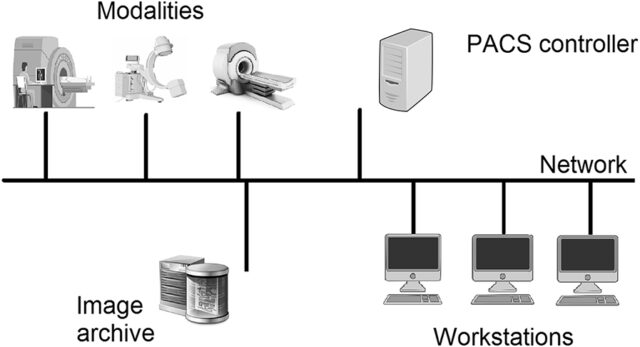What is the PACS system?
PACS a picture archiving and communication system is simply a medical imaging technology that gives economical management, retrieval, storage, distribution, and presentation of medical images. PACS system is used for digitally transmitting electronic images and reports. This puts an end to the need for manually filling, retrieving, or transporting heavy film jackets. This is a great help for health care organizations for capturing, storing, viewing and sharing any kind of images at both external and internal pace.
There is a universal format for PACS image storage and transfer that is DICOM. DICOM is a Digital Image and Communication in Medicine. DICOM enables PACS, RIS (Radiology Information System), and other medical imaging systems for connection to passing the data to each system and other healthcare facilities.
Major components of PACS
The four major components of PACS are:
- Imaging modalities are the imaging system to do the real patient scanning for the production of medical images.
- Securing network to the database for the uploading and transferring of images.
- A workstation that enables the radiologist and doctors to view and studying the images.
- Storage Archives for securing storage area in which the image and the supporting documents are available to the people enabled to view it.
Why combine PACS software with RIS?
There are benefits of combining PACS software with RIS are:
- Note how radiology PACS often gets arranged on the other side of the RIS.
- The RIS is system is used by radiologists for noting the radiology history of their patients along with scheduling appointments. But the main purpose of PACS is to store and retrieve images.
- Combining PACS software with the RIS enables the hospital radiology department to perform better as it allows the images to get potentially stores, retrieved, and transferred.
Advantages of the PACS system
The core advantages of the PACS system are:
- Remote Access
- Replacement of Hard Copy based medical images like film archives.
- PACS provides the electronic platform for radiology image interfacing with several other medical automation systems like HIS, EMR, etc.
- PACS is used by radiologists for the management of their workflow of patient exams.
Benefits for diagnosis
- Better diagnosis
- Improved accessibility to past and current records of patients
- Integration to file and speed retrieval features.
Benefits for a physician referral
- PACS system allows the better outcomes for the patient.
- PACS system decreases the length of stay.
- PACS system enables earlier intervention and better management of patients.
- PACS system reduces legal costs because of maladministration of loss of time, lack of patient’s history, and such other issues.
Benefits for patients
- PACS system eliminates the exposure from the radiation of x-ray equipment.
- PACS system shortens the time of examination.
- PACS system eliminates the inconvenience for patients for attending the hospital again and again for examinations.
- PACS system decreases the chance of negative reactions to the contrasting agents.
Benefits for the hospital
- PACS system helps in having better communication with physicians.
- PACS system benefits in bettering the administration of hospitals.
- PACS system aids for better radiology training to other students by accessing online image files and for digital teaching files.
Beneficial considerations of the PACS system
PACS beneficial considerations are:
- It allows you to store standard 2D and 3D images.
- It allows you to reduce the number of the same images making the data management speedy and efficient.
- It shows you the patient’s radiology history in chronological view.
- PACS allows the surgeons to view the images even before their patients get back to the examination room. Alongside, it aids in improving the quality of patient care it makes the workflow efficient and quick.
Best PACS systems
There are a lot of PACS systems available but the best of all the PACS system would be the one that suits all your needs that also impacts your practice size, the budget limitations, and current infrastructure.
Here are a few PACS systems that you can consider.
- PostDICOM
- Ambra health
- Study cast
- Quickpacs
Radiology is the one field that has quite an interest in the system of PACS. The radiology PACS gets frequently deployed with a RIS. PACS system is not just beneficial for radiologists, but it is highly advantageous for all the hospital administrators and referring physicians.
Frequently Asked Questions
PACS stands for picture archiving and communication system. In order to store, retrieve, and distribute medical images and related information within a healthcare facility or among several healthcare organizations, a PACS system is a comprehensive digital solution.
PACS systems work by capturing, storing, and managing medical images such as X-rays, CT scans, MRIs, and ultrasound images in a secure and centralized digital repository. These images can then be accessed, reviewed, and shared by authorized healthcare professionals for diagnostic and treatment purposes.
Some key benefits of using a PACS system include improved access to medical images, faster image retrieval, and review, enhanced collaboration among healthcare professionals, reduced costs associated with film-based systems, and seamless integration with other healthcare information systems.
By eliminating the need for physical film storage, retrieval, and transport, a PACS system streamlines the radiology workflow. It enables faster image availability, reduces waiting times for patients, and allows radiologists to work more efficiently, leading to improved patient care.
Yes, one of the advantages of a PACS system is its ability to be accessed remotely. Authorized healthcare professionals can securely access and review medical images from anywhere with an internet connection, facilitating telemedicine, remote consultations, and second opinions.
Yes, a PACS system prioritizes data security and privacy. It employs advanced encryption methods to protect patient information and ensures compliance with relevant regulations, such as the Health Insurance Portability and Accountability Act (HIPAA) in the United States.






